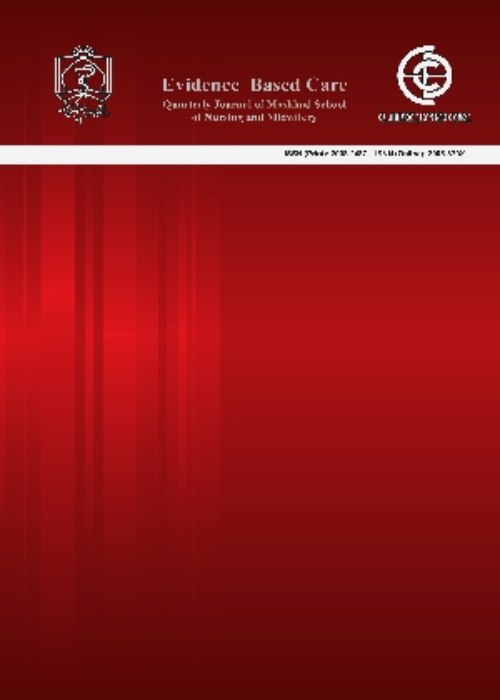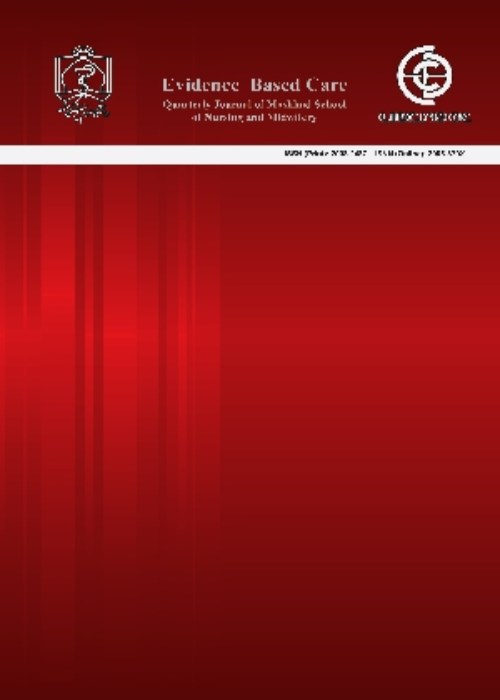فهرست مطالب

Evidence Based Care
Volume:13 Issue: 3, Autumn 2023
- تاریخ انتشار: 1402/07/09
- تعداد عناوین: 8
-
-
Pages 7-16BackgroundInability of self-care in heart failure patients worsens the symptoms and complications of heart failure and increases rehospitalisation in these patients. Providing education during hospitalization is inadequate because they need support and follow-up for ability to perform self-care. Self-care ability is influenced by self-efficacy which affects the quality of life in heart failure patients.AimThe present study was performed with aim to examine the impact of structured education and telemonitoring on self-care, self-efficacy and quality of life in heart failure patients.MethodThis randomized controlled trial study with a pretest-posttest design was performed in the Cardiac Clinic. The subjects were randomly divided into the intervention and control groups (n=68 per group). The intervention group received structured education and was followed up using telephone monitoring based on heart failure care. Telemonitoring was done every week for 20 minutes for four weeks. The control group received the routine care. Both groups completed the questionnaires on self-care, self-efficacy, and quality of life.ResultsHalf of the participants were elderly. At baseline, the mean scores for self-care, self-efficacy, and quality of life did not differ significantly between the two groups (p>0.05). After the intervention, the scores of self-care (20.67±1.88), self-efficacy (2.75±2.21), and quality of life (8.42±2.05) in the intervention group showed significant differences compared to the control group (p<0.001).Implications for Practice: Structured education and telemonitoring follow-up regarding heart failure care significantly increased self-care abilities, self-efficacy, and quality of life in heart failure patients.Keywords: Cardiac failure, self-care, Self-efficacy, telemonitoring
-
Pages 17-26BackgroundComplex medical condition, monitoring, treatment process and multitude devices in Intensive Care Unit (ICU) increase the risk of errors and unintended adverse events. So, Patient safety is important for ICUs nurses.AimThe present study was performed with aim to develop, implement and evaluate patient safety training program for nurses.MethodThis semi-experimental study with pretest and posttest design was conducted on 162 nurses recruited from the ICUs in three educational hospitals of Kermanshah University of Medical Sciences. To develop the program, the nurses’ needs were assessed using a patient safety questionnaire (84 items) developed based on WHO guideline on nine patient safety statement. After confirming validity and reliability, the questionnaires were distributed among nurses in rotation shifts and retrieved in the same shifts. After developing and implementing the program based on Kern's model, nurses’ knowledge and performance in patient safety measures was re-examined. The data were analyzed by SPSS (version 21) and independent and paired t-tests.ResultsThe mean score of patient safety knowledge of ICU nurses significantly increased from 51.48±34.35 before the intervention to 57.29±24.17 after the intervention (p<0.001). Also, the mean score of performance significantly increased from 42.53±30.64 before the intervention to 48.91±22.15 after the intervention (p<0.001).Implications for Practice: The implementation of the patient safety education program for ICU nurses was effective in improving their knowledge and performance of patient safety measures. So, the interventions based on educational model can provide the effective program according to time and cost.Keywords: education program, Intensive Care Unit, nurse, Patient safety
-
Pages 27-34BackgroundDiabetes is the most common and severe metabolic disease in human. Self-treatment behaviors are common problems among diabetic patients.AimThe present study was conducted with aim to identify the factors related to self-treatment behaviors among type 2 diabetic patients based on the Theory of Planned Behavior (TPB).MethodThis cross-sectional study was carried out on 381 diabetic patients referred to Hamadan Diabetes Research Center in 2019, which were recruited with a simple sampling method. The participants completed a self-administered questionnaire, including demographic characteristics and TPB constructs. Data were analyzed by SPSS software (version 18) and descriptive statistics, one-way ANOVA, Independent t-test, and Linear regression. p<0.05 was considered statistically significant.ResultsThe mean age of the participants was 55.69±11.45 and 68.2% of the patients were male. Also, 22.3% of participants did not refer to a specific physician to monitor the diabetes treatment. Significant differences were found in the mean score of self-treatment behaviors related to gender, dwelling, and having a specific physician (p<0.05). According to the result, the TPB construct explained 16% of the variance in the frequency of self-treatment behaviors. Attitude (β=0.227) and perceived behavior control (β=-0.110) were the best significant predictors of behavioral intention (p<0.05).Implications for Practice: The findings obtained in the present study suggest that applying TPB would be an efficient tool for predicting self-treatment behaviors among diabetic patients.Keywords: Attitude, Diabetes, Self-efficacy, Self-treatment
-
The Relationship between Missed Nursing Care, Work Environment Conditions and Patient Safety CulturePages 35-41BackgroundThe rate of missed care depends on several factors which can affect the quality of care and treatment.AimThe present study was conducted with aim to investigate the relationship between missed care, work environment and patient safety culture.MethodThis cross-sectional study was conducted on 380 nurses working in the teaching hospitals affiliated to Jundishapur University of Medical Sciences in Ahvaz, Iran. Sampling was done through a stratified random sampling method from Jan 2019 to Jul 2020. The data collection tools included a demographic data form, the Missed Nursing Care Questionnaire, the Practice Environment Scale of the Nurse Work Index, and the Hospital Survey on Patient Safety Culture. Data were analyzed using SPSS software (version 25) and one way ANOVA, Pearson correlation and Kolmogorov-Smirnov tests. p<0.05 was considered statistically significant.ResultsThree most prevalent missed nursing care were overall patient assessment in each shift (96.1%), administering the drugs up to 30 minutes before or after the scheduled time (94.7%), and measuring the vital signs as ordered (94.1%). The mean scores of missed care were significantly higher among nurses with lower ages (p<0.0001) and less work experience (p<0.0001). A significant inverse correlation was found between missed care and the overall score of patient safety culture (r= -0.22, p<0.0001). Also, a significant correlation was found between missed care and the overall score of the work environment index (r=0.285, p<0.0001).Implications for Practice: Nursing managers can reduce the rate of missed nursing care by improving the working conditions of nurses and educating them about patient safety.Keywords: Environment, Missed care, Nursing care, Patient safety
-
Pages 42-49BackgroundMothers experience challenges when a premature infant is born and admitted to the neonatal intensive care unit (NICU).AimThe present study was conducted with aim to investigate the effect of infant massage by the mother on maternal anxiety and self-esteem.MethodThis randomized clinical trial study was performed on mothers of 63 premature infants admitted to the neonatal intensive care unit. Mothers were randomly assigned into the intervention and control groups. Mothers in both groups completed Rosenberg's Self-esteem and Beck Anxiety questionnaires. The mothers in the intervention group were trained to massage their infants. They applied a 15-minute massage 3 times a day for two weeks. The mother in the control group received routine education of hospital including pamphletes and self relaxation techniqes. After two weeks, the mothers in both groups again completed Rosenberg Self-esteem and Beck Anxiety questionnaires. Data were analyzed by SPSS (version 16) and Mann-Whitney U and Wilcoxon test. p<0.05 was considered statisically significant.ResultsThe mean score of anxiety reduced more significantly in the intervention group compared to the control group (39.12 vs. 11.52) (p<0.05). The mean score of self-esteem showed a 16.94-point increase in the intervention group compared to 1.58 points increase in the control group (p<0.05).Implications for Practice: Massage of premature infants by their mothers is a useful and cost-effective way to reduce maternal anxiety and increase maternal self-esteem in the NICUs. Therefore, educating this technique is recommended in the NICUs.Keywords: Anxiety, Infant, Massage, mothers, Premature, Self-Esteem
-
Pages 50-58BackgroundHTLV-1-associated myelopathy is associated with constant stress, so it is very important to cope with this disease. To improve the coping of patients with this disease, it is necessary to deeply identify its barriers.AimThe present study was conducted with aim to explain the barriers to cope with HTLV-1-associated myelopathy/tropical spastic paraparesis.MethodThis qualitative content analysis approach was performed on 17 patients with HTLV-1-associated myelopathy/tropical spastic paraparesis, who referred to Ghaem hospital clinic. Data were collected by conducting semi-structured in-depth interviews in a private room of the clinic. The Graneheim and Lundman's qualitative content analysis method was used for analyzing.ResultsIn this study, 5 subcategories and 2 main categories (internal barriers to coping with the disease, challenges with socioeconomic barriers) were developed. The main theme abstracted was also "chains of stagnation and regression of passing the disease".Implications for Practice: Considering that health care professionals' knowledge about HTLV-1-associated myelopathy/tropical spastic paraparesis and patients' experiences is very little, the results of this study can be a basis to design a suitable and context-based care framework to improve the coping responses of patients.Keywords: Adaptation, HTLV-I-Associated Myelopathy, Human T-lymphotropic virus 1, spastic paraparesis
-
Pages 59-69Background
Intuitive concerns have been expressed that the biopsychosocial adversities associated with the COVID-19 pandemic may increase the suicide attempt rate.
AimThe present study was performed with aim to determine the risk factors of suicidal motivations during the COVID-19 pandemic and confirm the psychological pain theory (PPT), psychological ssmotpmy (PS), and early life experiences (ELE).
MethodThis cross-sectional and descriptive-correlational study was performed with structural equation modeling (SEM). Participants were 300 suicide attempters who ewew referred to Razi Hospital of Ahvaz mepm May 2021 to December 2021 and were selected by purposeful sampling method. They responded to the Suicide Attempt Motivations Questionnaire, Mental Pain Questionnaire, Revised List of 25-Item Symptoms and Early Life Experiences Questionnaire. Structural equation modeling, AMOS-24, and SPSS-26 were used to evaluate the proposed model.
ResultsThe results of Pearson's correlation coefficient showed a positive and significant relationship between ELE and PS with psychological pain and suicidal motivations (p≤0.05). The results indicated that in the first order, 62% of the variance of dimensions of PS by ELE, in the second order, 78% of the variance of psychological pain is explained by the ELE and PS and ni the third order, 81% of the variance of suicide attempt motivations is directly and indirectly explained by the ELE, PS, and PP.Implications for Practice: Understanding the most common antecedents of suicide attempt motivations can enrich conceptual models of suicide and facilitate the design of suicide prevention and intervention programs.
Keywords: Early Life Experiences, Psychological Pain, Psychological Symptoms, Suicidal Motivations -
Pages 70-77BackgroundBronchial asthma is a common chronic disease in adults. The lack of definitive treatment caused the patients with bronchial asthma to look for non-pharmacological interventions. One of these interventions is massage therapy.AimThe present study was conducted with aim to compare the effect of reflexology versus stroke massage on respiratory symptoms in patients with bronchial asthma.MethodThis randomized controlled clinical trial study was conducted in 2020 on 120 patients with bronchial asthma referred to Shahid Muftah Clinic of Yasuj city. The participants were selected through non-probability sampling method and randomly assigned to three equal groups: reflexology, stroke massage, and control (n=40). Four sessions of interventions were performed. Respiratory symptoms were assessed using pulse oximetry, stethoscope, observation and respiratory exam before and after the interventions. Collected data were analyzed by SPSS software (version 21) and Chi-square and one-way analysis of variance (ANOVA) tests. p<0.05 was considered statistically significant.ResultsThere was no significant difference among three groups in terms of mean score of arterial oxygen saturation (p=0.148) and respiratory rate (p=0.520) after the interventions. However, there were significant differences among three groups regarding mean score of respiratory symptoms, including daily cough (p=0.012), nocturnal cough (p=0.007), exertional dyspnea (p=0.034), exertional cough (p=0.024), and limited activity (p=0.037). These differences were observed between the two interventions groups and the control group, however, no significant differences were observed between the two intervention groups.Implications for Practice: Reflexology and stroke massage could similarly reduce respiratory symptoms of patients with bronchial asthma.Keywords: Asthma, Massage, Reflexology, Respiratory symptoms, Stroke


